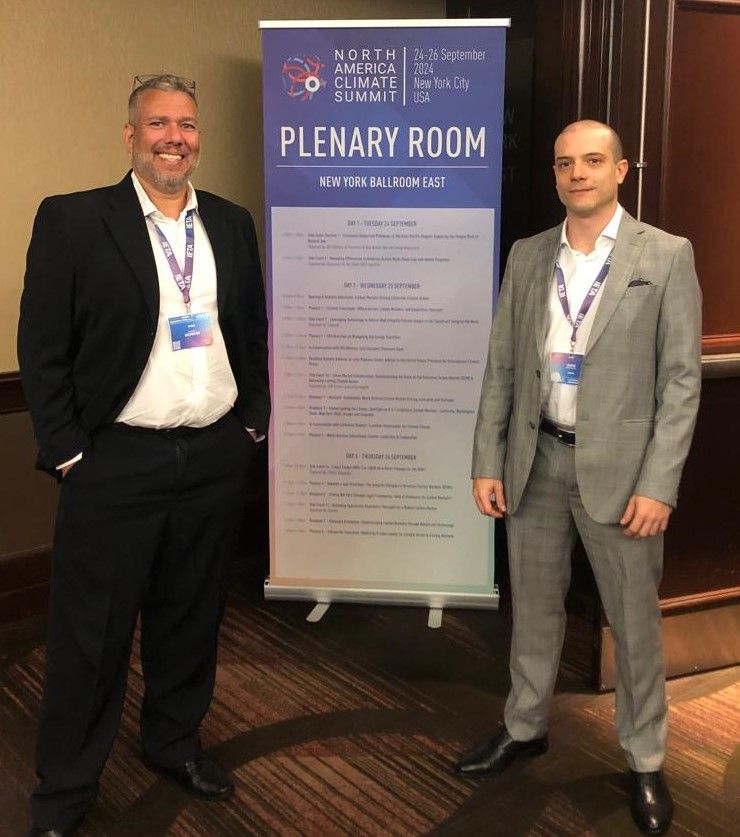A Voluntary Distraction

Kevin Conrad, Executive Director of the Coalition for Rainforest Nations, says compliance carbon markets offer more effective support to the goals of the Paris Agreement.
The Global Stocktake is a key process established under the Paris Agreement scheduled to take place at COP28 in Dubai. Its primary purpose is to assess the collective progress of signatory countries in addressing climate change and limiting global warming to well below 2°C above pre-industrial levels and pursuing efforts to limit the temperature increase to 1.5°C.
The process involves the assessment of various components, including emissions reduction efforts, adaptation strategies, the provision of financial support, and the state of climate science. It relies on a combination of scientific data, country reports, and expert reviews to provide a comprehensive and definitive evaluation of global progress in addressing climate change.
Ahead of COP28, the United Nations Framework Convention on Climate Change (UNFCCC) conducted analysis, in collaboration with the Coalition for Rainforest Nations (CfRN) that demonstrated which countries are meeting and missing their climate targets, including countries that are superseding their targets as carbon negative. Among them were Suriname and 12 other rainforest countries named ‘net carbon removers’ ahead of COP28 Global Stocktake.
To understand the role of net carbon removers within the broader net zero conversation, it important to breakdown how the Paris Agreement is structured, explains Kevin Conrad, Executive Director of the CfRN, with its foundation built around ‘climate stability’.
The CfRN is an intergovernmental organisation that was established in 2005. Its primary mission is to represent and advocate for the interests of tropical rainforest countries in international climate change negotiations and related environmental initiatives. Grow the ledger
“The notion here is that in the future, emissions will be paired with removals; that’s how we reach climate stability,” Conrad tells ESG Investor, noting that by 2050, if all goes to plan, there is an acknowledgment that there will still be eight gigatonnes (Gt) of annual CO2 emissions. Currently global CO2 emissions from energy combustion and industrial processes sit at 36.8 Gt, according to data from the International Energy Agency (IEA).
Conrad says that the goal is to grow the net remover ledger, because those are the countries that can partner with net emitters that are unable to completely remove all emissions out of their economy to achieve climate stability under the Paris Agreement.
Of the 29 net removers, explains Conrad, the vast majority are poor countries with large rainforests, which serve as the world’s lungs, pulling CO2 out of the atmosphere through photosynthesis. The rub, however, is that these net removers are not being compensated for their ecological services, meaning that currently some of the world’s poorest countries are cleaning the atmosphere for wealthy, i.e. the net emitters, for free.
“It’s unreasonable to expect poor countries to continue providing this valuable service into the future for free while allowing wealthy countries to profit from fossil fuels,” says Conrad.
“How do we keep those economies in the ledger that are already on the path towards carbon neutrality? How do we finance more economies to join this ledger? This is the primary task that should be undertaken.”
The fastest way to improve the situation, he argues, is by putting capital into net removers’ economies, as well as into those countries who are sitting on the border to becoming carbon neutral that require investment into renewables and their forested areas.
Unfortunately, it’s not happening yet, and this is why the next two years are critically important, says Conrad. While COP28 in Dubai is primarily focused on the Global Stocktake to understand where we currently stand with regards to addressing climate change, he expects COP29 to see focus shift to figuring out how to allocate the necessary funds to make the Paris Agreement a reality.
“A big waste of time”
One method for allocating funds to net removers is via voluntary carbon markets (VCMs), which are platforms or systems where individuals, organisations, and companies can buy and sell carbon credits, also known as voluntary carbon offsets or Verified Carbon Units.
VCMs continue to be seen as an attractive means by corporates and investors of offsetting CO2 emissions, despite having come under heavy scrutiny due to press investigations identifying lack of transparency, miscalculations, and inconsistencies in credit quality.
These markets operate separately from compliance carbon markets, such as Europe’s cap-and-trade system, which are mandated by governments to regulate greenhouse gas emissions from certain sectors.
According to Conrad, VCMs have done a good job in getting companies to start thinking about emission reductions, net zero plans, and how they engage with net remover countries.
However, in terms of actual contribution, it’s been a “big waste of time”, with VCMs still accounting for just 1% of global CO2 emissions reductions after being established some 20 years ago.
“If you look at our total CO2 emissions, you can see what is attributed to fossil fuels and what is due to land use change,” says Conrad, noting that emissions from land use change have been gradually diminishing since 2000.
“The REDD+ mechanism, which started in 2005, has generally been doing what it’s supposed to do – attracting attention to forests. However, it’s been woefully insufficient in putting capital into the forests.
REDD+ [Reducing Emissions from Deforestation and Degradation] helps fund projects to prevent deforestation in areas at risk of such activity. Proponents say it is a vital way to pay local communities, which otherwise lack basic needs and economic opportunities, to stop logging or burning down forests for money or land.
While the REDD+ mechanism, which is recognised under Article 5 of the Paris Agreement, is generally doing its job in reducing emissions from deforestation and forest degradation in developing countries, Conrad argues that it is like a “Ferrari without any petrol”.
Compliance carbon markets on the other hand already cover 20% of global emissions, with carbon credits in these jurisdictions subject to various forms of regulation, including taxation.
In 2022, VCMs mobilised a mere US$1.2 billion of climate finance globally while accounting for less than 0.8% of emissions, says Conrad. In contrast, compliance markets mobilised US$938 billion in the same year, highlighting their effectiveness in rallying finance.
Given this context, the question arises: should we expand VCMs or focus on increasing regulation to extend compliance markets? Conrad argues that, given the limited time left to address climate change, the world should aggressively pursue regulation rather than relying on VCMs to “save the day”.
“VCMs often put money in the wrong place,” he says, adding that the majority of the funds raised end up with foreign project developers and traders, with only a fraction going towards the actual reduction of emissions in the host country, with long-term cash flow audits usually missing, leading to a lack of transparency.
Integrity matters
To tackle ongoing controversies around the quality, credibility and transparency of VCMs, the demand side-focused Voluntary Carbon Market Integrity Initiative (VCMI) published its Claims Codes of Practice in July for companies looking to credibly and transparently use VCMs as part of their climate action.
Within the guidance, VCMI explicitly said that companies must select carbon credits which meet “stringent quality thresholds” in line with the supply side-focused Integrity Council for Voluntary Carbon Markets’ (ICVCM) Core Carbon Principles (CCPs).
This follows a joint commitment made by the VCMI and ICVCM in June to ensure investors in VCMs can invest confidently in high-integrity credits as part of their climate strategies.
Despite these steps, Conrad says that VCMs still primarily rely on avoidance credits for external projects that avoid or reduce emissions production, such as building a wind farm, and removal credits for projects that lower existing emissions.
Avoidance credits do not address the pressing need to reduce emissions, he says, adding that to meet climate goals, the world must reduce emissions by around 2.5 Gt per year over the next decade to keep global warming below 1.5°C.
“Avoidance doesn’t contribute to achieving this goal, as it allows companies to profit without actively reducing emissions at the source,” he says, noting that under the Paris Agreement avoidance is outlawed, with only two approaches permitted: reducing emissions at the source and removals of carbon from the atmosphere.
“Voluntary markets fail in all these aspects – impact, mobilisation of cash flow, and atmospheric integrity,” he says, concluding that the regulated compliance regime appears to be the more effective approach in tackling climate change, as it mobilises significantly more finance and enforces emissions reductions.
Carbon cowboys
Speaking at the Africa Climate Summit earlier this month, Mohamed Adow, Founder and Director of Power Shift Africa, which aims to mobilise climate action in the continent, labelled carbon markets as a “distraction” from proper conversations aimed at attracting climate funding for Africa from high-polluting countries and companies in the Global North.
Conrad told ESG Investor that he agreed with Adow’s sentiments and says it has been “disheartening” to see what he refers to as “carbon cowboys” attempting to convince Africa that voluntary markets were their saviours.
“The entire structure of the voluntary market is about extracting carbon from local economies and profiteering in wealthy economies rather than helping those economies accrue climate finance at the necessary scale to reduce emissions,” he says.
The CfRN plans to discuss this issue with the UNFCCC Secretariat in the hope of ensuring that participants in VCMs are actually supporting the Paris Agreement instead of undermining it.
The organisation also plans to play its part in helping to develop and scale compliance carbon markets, with one of the CfRN report’s net removers – Suriname – aiming to become the first nation to sell carbon credits under the Paris Agreement.
As a ‘carbon-negative’ country, Suriname will soon have approximately five million tonnes of credits known as ‘Internationally Transferable Mitigation Outcomes’ (ITMOs) that it plans to issue.
“This marks the first time to catalyse the Paris compliance carbon markets,” he says, adding that to achieve this Suriname must navigate a series of regulatory procedures to ensure that its contributions are integrated into the global accounting system.
“This process involves providing reports every two years detailing the fate of these internationally tradable credits,” says Conrad. “Questions such as who purchased them, whether they were retired, or if they are being held must be answered – these reports are crucial for transparency and accountability.”
Ultimately, for carbon markets to function effectively, says Conrad, they must be part of a global regime where the carbon credits being purchased represent real reductions or removals in an economy, surpassing their nationally determined contributions (NDCs).
“It is vital that these credits are properly accounted for, whether they are used by a government or a company.”
No silver bullet
While Conrad stresses the importance of carbon markets to achieve the goals of the Paris Agreement, he says that it’s also essential to understand that a substantial amount of funding must be directed towards developing economies to support them in pursuing a sustainable path that extends beyond the scope of these markets.
“Carbon markets cannot be the only solution,” he says, “Part of this involves recognising that markets are most effective in economies that are fairly advanced and have the capacity and necessary regulatory frameworks in place.”
He also recognises that there’s also a significant need for climate finance in areas such as resilience, addressing loss and damage, and investing in renewables, among other things, where carbon markets may not function as efficiently.
“Whenever I discuss carbon markets, I want to be clear that carbon markets have to work; they are an important component of what the Paris Agreement has built,” he says, but asserts that a diversified approach is crucial for overall success.






